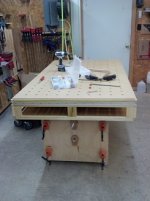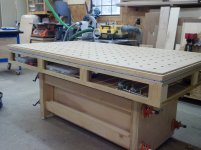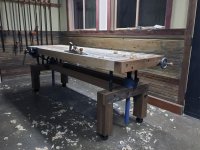This is another approach to an adjustable height table allowing the height to range from almost zero. Instead of a lateral up and down, the principle of this approach is the scissor effect; the draw back being that there is no accommodation for under-table storage. The overhang would have to be sufficient to allow for a wheelchair. My preference for height would be to be at the 18" to 24 " height to allow for finish work. This would put a project table with a top with a height of 30 inches at 48 inches and allow for convenient sanding and finish application. The upper height would be sufficient to have convenient height for routing on a Leigh type jig, something like 36 to 40 inches from the floor.
Note: This video sound is annoying crash/boom so adjust volume accordingly.
T-track is a must around the perimeter as well as dog holes whether they be 20mm or 3/4." An accommodation for a drop-in router and surface slots for miter gauge runners would be handy so the table could be used with a contractor table saw.
Options : The table should allow for a custom top and locking wheels for mobility. A built in electrical distribution center would be useful as well as a boom and light option. The design might allow for standing the table on end perhaps with the wheels placed to allow for quick and convenient upright storage or wheeling the table onto the jobsite. The skids might have a leveling feature. A place for removable Moxon type vise would be practical and the soul of luxury. Removable work rests on the legs or hanging from the t-track would make it possible to work vertically on a door slab. Other options would include T-track boxes set up for tools, drills, sanders and glue bottles and perhaps a holster type box for squares etc.
Hans: One other suggestion. Contact your local VA facility that has a section on Adapted Housing. These folks are experts on wheel-chair access and can give you solid suggestions on heights and widths to guide any design you might undertake that would involve wheelchair accommodation.




